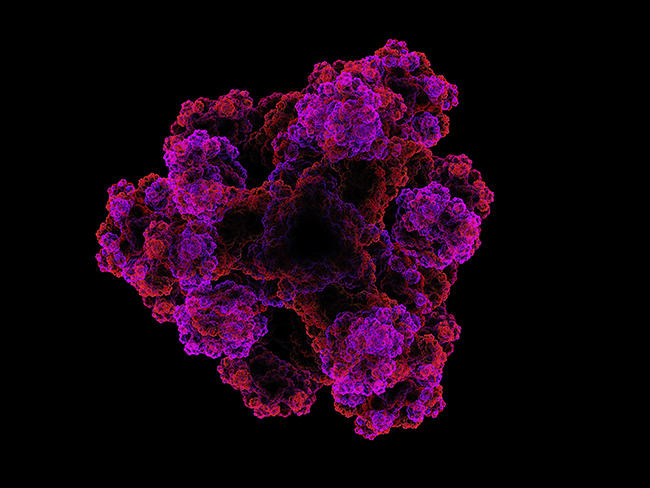Structural and Biophysical Biology
Structural biology for cancer research focuses on understanding the structure and morphology of biomolecules that play a role in tumorigenesis.
Key research areas include:
- 3-D structure(s) of biomolecules and macro-molecular complexes associated with cancer development and progression
- Structure and assembly of cellular organelles and extracellular molecular assemblies associated with cancer growth
- Structural and/or biophysical studies on activators and inhibitors of oncogenic molecular pathways
- The molecular, chemical, and physical basis of enzyme catalysis and regulation in molecular pathways associated with cancer development and progression
Emerging areas relevant to this research include the role and unique structural features of intrinsically disordered proteins and protein regions and technical advances in structure elucidation (including support for large scale resources for structural biology and cryo-electron microscopy).
Molecular and Cellular Applications
This research area supports new technologies and approaches for characterizing, analyzing, and perturbing molecular and cellular components of cancer.
Key research areas include:
- Characterizing the composition and organization of genomes, transcriptomes, proteomes, and metabolomes, as well as their variations in cancer initiation and development
- Methodologies for selecting and preparing cancer-related samples, including isolated components (such as proteins or metabolites) or in-tact systems.
- Novel methods for identifying and interrogating spatial and temporal signaling, including multi-scale signaling and the interaction of the physical environment of cancer with molecular signaling
- Synthetic biology approaches to designing, developing and using unique or modified molecules or cells to perturb cancer signaling pathways or other systems to understand their function
Emerging areas relevant to this research include the multi-omic single-cell analysis of tumor samples, spatial genomics characterization of tumors to understand cellular interactions in the tumor microenvironment, and the construction of tumor atlases that preserve spatial information related to signaling. The development of technical approaches to discover new alternatively spliced transcripts and complex chromosomal structural variations in cancer, as well as to characterize extrachromosomal DNAs in cancer development, is also an important area of research.
Bioinformatics and Data Science
Studies focused on developing and/or using bioinformatics methods and software tools for data management and analysis to improve the understanding of cancer biology.
Key research areas include:
- Development or adaptation of computational methods to identify features in data, integrate disparate multi-modal data, and provide user-interfaces that enable discovery and hypothesis generation
- Data wrangling approaches including data science approaches to reproducibility, uncertainty quantification, data annotation, and data mining
- Developing new computational methods and platforms for research collaboration and research training
Emerging areas relevant to this research include novel media and interaction modalities for visualizing and deciphering cancer complexity, the adaptation of game technologies to enhance data processing, visualization, and enhance usability of the data for a wide variety of users, and integration of spatial transcriptomics with other multimodal data sources enabling a more holistic understanding of cancer biology context.
Computational Biology, Mathematical Modeling, and Systems Biology
Developing or adapting computational, mathematical, or statistical modeling methods used in other fields to provide an understanding of and test hypotheses about biological processes and cancer development is a critical field of research.
Key research areas include:
- Mathematical, statistical, and computational modeling or simulation of cancer initiation, development, and response to therapy
- Modeling tumor cell population dynamics and evolution in cancer development and progression
- Development or early application of new computational, mathematical, and statistical approaches to understand cancer processes
- Exploring theoretical biological concepts in cancer biology
Emerging areas relevant to this research include Artificial Intelligence (A.I.)-driven analysis technologies for the prediction of cell and cell population growth and development, hybrid modeling approaches that bring together data driven modeling (e.g. A.I.) and mechanistic modeling to approach complex cancer questions, interpretable or explainable artificial intelligence models of cancer initiation and progression, and morphology-driven molecular characterization and cells and cell dynamics.
Bioengineering and Biotechnology
Research in this area involves technology development, instrumentation development, bioengineering, nanotechnology, integrative biological approaches, and the use of molecular and cellular imaging to observe, perturb and test hypotheses about cancer organization at multiple biological scales
Key research areas include:
- Developing new technologies focused on systems in cancer biology and single-cell technologies designed to study cancer processes, including those that preserve spatio-temporal information about the developing cancer
- Synthetic biology and cell engineering, including the construction of novel molecules or biochemical pathways and unique cellular features that enable testing of biological hypotheses related to cancer, to study and understand cancer growth
- Adopting a physical sciences perspective in approaching cancer organization, signaling and evolution
- Developing and adapting new materials to more accurately model and re-create cancer systems to use in hypothesis testing
- Using imaging technologies and their associated computational and mathematical analysis methods to view cancer in new ways at the sub-cellular, cellular and tissue scale ((e.g., electron and X-ray microscopy, crystallography, and optical and fluorescence microscopy)
- Development of new or adapted systems approaches, including the integration of mathematical and computational models with experimental approaches, to understand the underlying mechanisms and processes of cancer initiation and development
Emerging areas relevant to this research include the integration of understanding synthetic biology approaches with tissue engineered systems, creating a more realistic, wholistic cancer system in which to test biological hypotheses, as well as the development of more diverse models, controlling for and better representing unique patient populations or population dynamics that affect the underlying biology of cancer.
Open Innovation, Citizen/Community Science, Crowdsourcing, and Participatory Research
This area of research focuses on creative strategies, methods, and technologies to accelerate collaborative, inter-disciplinary teams and approaches that enable a broader community of solvers to work together on ideas and problems in cancer research.
Key research areas include:
- Partnering with the public to solve research questions through citizen science
- Enabling and accelerating cross-disciplinary research by catalyzing new partnerships
- Understanding how the dynamics of the development and sustainment of teams involving individuals from diverse backgrounds and fields
Emerging areas relevant to this research include bringing games and game design principles into the cancer research space to enable a wider variety of solvers and more creative solutions, and understanding the ethical and social implications of community driven or participatory science in basic research.

